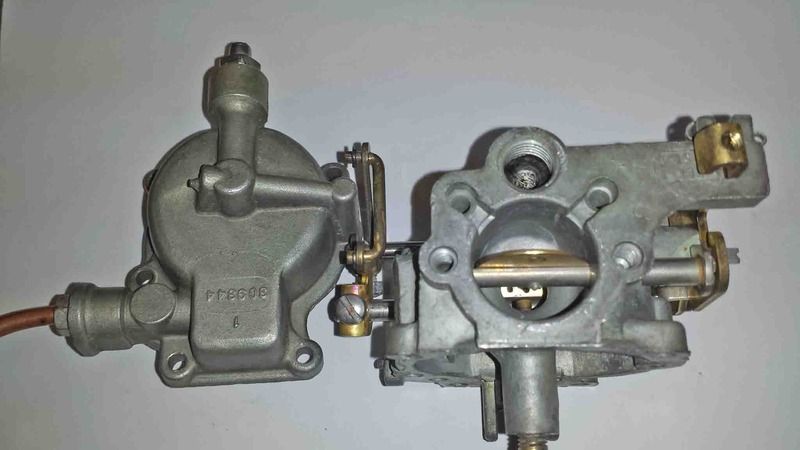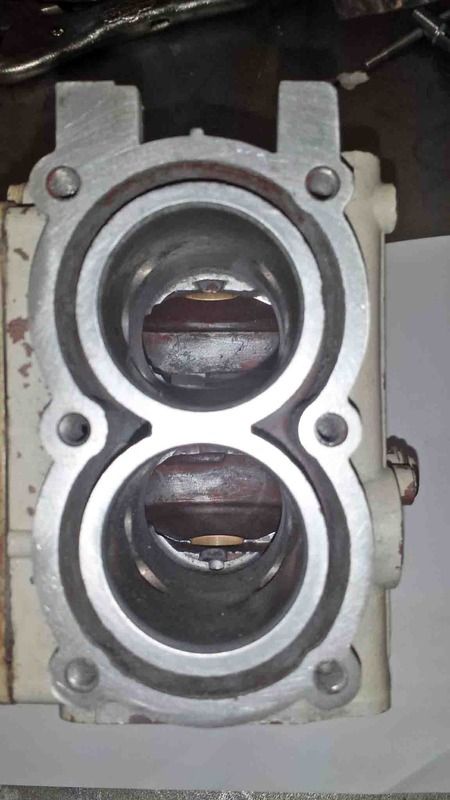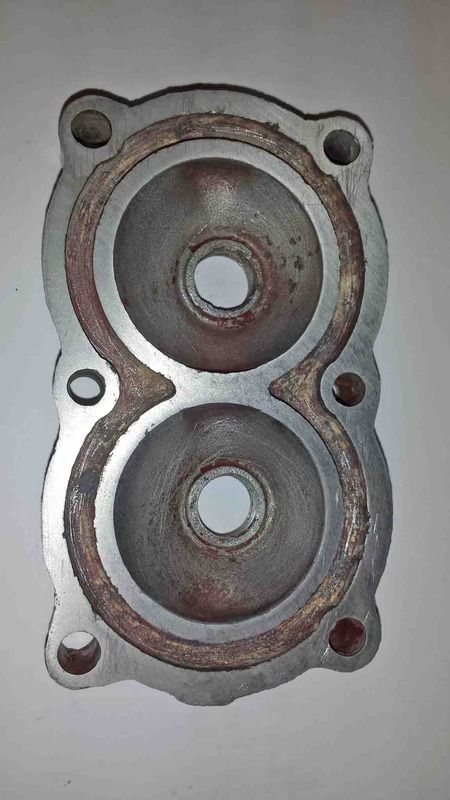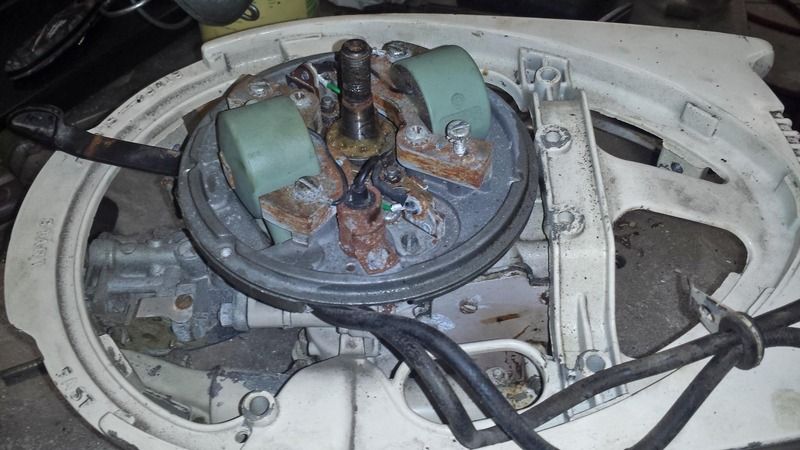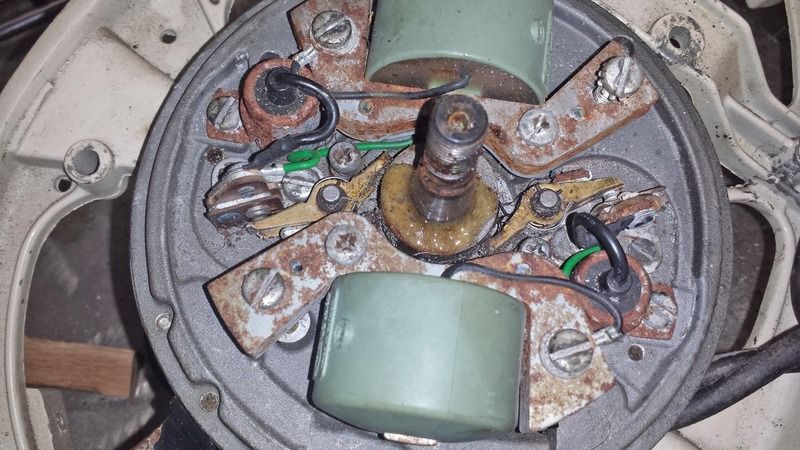helicopterjohn
Seaman Apprentice
- Joined
- Jul 18, 2012
- Messages
- 40
A friend of mine just gave me a 1964 Johnson JH19A outboard motor. The motor exterior looks really nice for its age. I thought it might be a nice motor to restore.
Overview:
The motor was locked up and the pistons were frozen to the cylinder walls. Tried several applications of PB Blaster over several days and was unable to free it up. I finally got the pistons out but damaged one of the rods (stamped 277168 on the side of the rod). Also, the rings were frozen and broke when they were removed. The cylinder walls honed up nicely and I think the block will be serviceable as well as the crankshaft. This motor has bronze bushings on the crank and rods (no needle bearings).
The carb was corroded badly and was not usable.
I found a used carb on e-bay off of a running Jw18 Johnson 3 HP which from the pictures supplied looked identical to mine. I ordered it and it is on the way. It may require a rebuild kit but I see that they are readily available.
The reed plate was pitted where the reed valves seat on it and is un-usable. I have made necessary cad/cam drawing for it and can easily duplicate it on my CNC machine. The reeds themselves seem to be in good shape.
As I mentioned above I have at least one bad rod and the other is questionable. The pistons seem to be serviceable and would probably accept new rings.
I found a couple of used piston/ring/rod assemblies on e-bay that I think??? will work with my engine. From the pictures supplied I can see part of the casting number (i.e. 277???) can't see the last three numbers but would hope they are stamped 277168 like the ones in my motor. I made an offer of these items and hopefully they will work. Of course the rings may have lost their tension and I may need new ones. In reading other posts on similar 3hp Johnson Outboards here on the forum of this era I understand that the ring set (i.e.2 rings for one piston) are still available under part # 378412. Hopefully, these rings would fit my engine in case they are required.
My hope is that if I can solve the piston/rod/ring issue I should be well on my way to getting the motor to run.
The rest of the motor and associated parts came apart easily. None of the other parts had any signs of corrosion and the motor must have been used in fresh water only. The water pump and impeller are in great shape as well as the lower foot assembly and gear box, prop etc.
If anyone here has any input to verify the part numbers on the rings, rods, and pistons utilized in my JH19A Johnson 3hp 1964 model outboard and possible vendor choices I would appreciate your reply. Any other ideas suggestions would also be appreciated. Also the torque numbers on the rod bolts and head bolts would be appreciated.
Thanks,
John
Overview:
The motor was locked up and the pistons were frozen to the cylinder walls. Tried several applications of PB Blaster over several days and was unable to free it up. I finally got the pistons out but damaged one of the rods (stamped 277168 on the side of the rod). Also, the rings were frozen and broke when they were removed. The cylinder walls honed up nicely and I think the block will be serviceable as well as the crankshaft. This motor has bronze bushings on the crank and rods (no needle bearings).
The carb was corroded badly and was not usable.
I found a used carb on e-bay off of a running Jw18 Johnson 3 HP which from the pictures supplied looked identical to mine. I ordered it and it is on the way. It may require a rebuild kit but I see that they are readily available.
The reed plate was pitted where the reed valves seat on it and is un-usable. I have made necessary cad/cam drawing for it and can easily duplicate it on my CNC machine. The reeds themselves seem to be in good shape.
As I mentioned above I have at least one bad rod and the other is questionable. The pistons seem to be serviceable and would probably accept new rings.
I found a couple of used piston/ring/rod assemblies on e-bay that I think??? will work with my engine. From the pictures supplied I can see part of the casting number (i.e. 277???) can't see the last three numbers but would hope they are stamped 277168 like the ones in my motor. I made an offer of these items and hopefully they will work. Of course the rings may have lost their tension and I may need new ones. In reading other posts on similar 3hp Johnson Outboards here on the forum of this era I understand that the ring set (i.e.2 rings for one piston) are still available under part # 378412. Hopefully, these rings would fit my engine in case they are required.
My hope is that if I can solve the piston/rod/ring issue I should be well on my way to getting the motor to run.
The rest of the motor and associated parts came apart easily. None of the other parts had any signs of corrosion and the motor must have been used in fresh water only. The water pump and impeller are in great shape as well as the lower foot assembly and gear box, prop etc.
If anyone here has any input to verify the part numbers on the rings, rods, and pistons utilized in my JH19A Johnson 3hp 1964 model outboard and possible vendor choices I would appreciate your reply. Any other ideas suggestions would also be appreciated. Also the torque numbers on the rod bolts and head bolts would be appreciated.
Thanks,
John





















